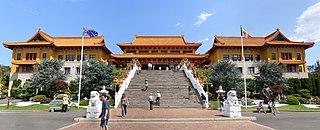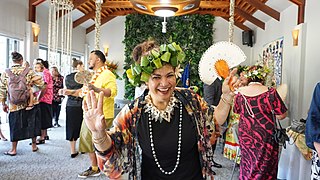
Thai Americans are Americans of Thai ancestry. The Thai American population is racially and ethnically diverse, consisting of many Thais who identify as mixed race and as Thai Chinese.
Burmese people or Myanma people are citizens or people from Myanmar (Burma), irrespective of their ethnic or religious background. Myanmar is a multi-ethnic, multi-cultural and multi-lingual country. The Burmese government officially recognises 135 ethnic groups, who are grouped into eight 'national races,' namely the Bamar (Burmans), Shan, Karen, Rakhine (Arakanese), Mon, Kachin, Chin, and Kayah (Karenni). Many ethnic and ethnoreligious communities exist outside these defined groupings, such as the Burmese Chinese and Panthay, Burmese Indians, Anglo-Burmese, and Gurkhas.
Laotian Canadians, are Canadian citizens of Laotian origin or descent. In the 2016 Census, 24,580 people indicated Laotian ancestry. Bilateral relations between Canada and Laos were established in 1954 with the formalization of the independence of the Kingdom of Laos from France. In August 2015, Canada's first resident diplomat opened the Office of the Embassy of Canada in Vientiane, Laos.

New Zealand Americans are Americans who have New Zealand ancestry. According to the 2010 surveys, there are 19,961 New Zealand Americans. Most of them are of European descent, but some hundreds are of indigenous New Zealand descent. Some 925 of those New Zealand-Americans declared they were of Tokelauan origin. The 2000 Census indicated also the existence of 1,994 people of Māori descent in US.

In Australia, Buddhism is a minority religion. According to the 2016 census, 2.4 percent of the total population of Australia identified as Buddhist. It was also the fastest-growing religion by percentage, having increased its number of adherents by 79 percent between the 1996 and 2001 censuses. The highest percentage of Buddhists in Australia is present in Christmas Island, where Buddhists constitute 18.1% of the total population according to the 2016 Census. Buddhism is the fourth largest religion in the country after Christianity, Islam and Hinduism.

Chinese New Zealanders or Sino-New Zealanders are New Zealanders of Chinese ancestry. The largest subset of Asian New Zealanders, many of the Chinese immigrants came from Mainland China, Hong Kong, Taiwan, or other countries that have large populations of Chinese diaspora. Today's Chinese New Zealand group is also composed of diasporic communities from Indonesia, Malaysia, Cambodia, Vietnam and Singapore. As of 2018, Chinese New Zealanders account for 4.9% of the population of New Zealand, and are the largest Asian ethnic group in New Zealand, accounting for 36.3% of Asian New Zealanders.

Thai Australians refers to Australians who trace their ancestry to Thailand or Thais who trace their ancestry to Australia. The Australian census recorded 45,635 Australians with Thai ancestry in the 2011 census.
Thais in the United Kingdom are British citizens who trace their Thai ancestry from migrants who have migrated from Thailand or Thais residing in the United Kingdom for work or educational purposes.
Asian people are the people of Asia. The term may also refer to their descendants.
New Zealanders of African descent represent less than 0.3% of New Zealand's population, although the number has been growing substantially since the 1990s.

Māori are the indigenous Polynesian people of mainland New Zealand. Māori originated with settlers from East Polynesia, who arrived in New Zealand in several waves of canoe voyages between roughly 1320 and 1350. Over several centuries in isolation, these settlers developed their own distinctive culture, whose language, mythology, crafts, and performing arts evolved independently from those of other eastern Polynesian cultures. Some early Māori moved to the Chatham Islands, where their descendants became New Zealand's other indigenous Polynesian ethnic group, the Moriori.

French New Zealanders are New Zealanders who are of French ancestors or a French-born person who resides in New Zealand.
Australian New Zealanders refers to New Zealanders whose origins are in Australia, as well as Australian migrants and expatriates based in New Zealand.

German New Zealanders are New Zealand residents of ethnic German ancestry. They comprise a very large amount of New Zealanders in terms of heritage, with some 200,000 people from the country having at least partial German ancestry. New Zealand's community of ethnic German immigrants constitute one of the largest recent European migrant groups in New Zealand, numbering 12,810 in the 2013 census. 36,642 New Zealanders spoke the German language at the 2013 census, making German the seventh-most-spoken language in New Zealand.

Buddhism is New Zealand's third-largest religion after Christianity and Hinduism standing at 1.5% of the population of New Zealand. Buddhism originates in Asia and was introduced to New Zealand by immigrants from East Asia.
New Zealand Canadians are Canadian citizens of New Zealand descent or New Zealand-born people who reside in Canada. According to the 2016 Canadian Census there were 15,396 Canadians who claimed full or partial New Zealand ancestry.
Asian New Zealanders are New Zealanders of Asian ancestry . At the 2013 census, 471,708 New Zealanders declared that they had an Asian ancestral background. This represents about 12% of all responses.
Bangladeshi New Zealanders refers to New Zealand citizens or residents who have full or partial Bangladeshi heritage or people who emigrated from Bangladesh and reside in New Zealand. There are around 1,623 Bangladeshis in New Zealand, according to the census in 2013. The largest Bangladeshi communities are mainly present in Auckland with smaller communities in other cities.
Syrian New Zealanders refer to New Zealanders of Syrian descent or Syria-born people who reside in the New Zealand.

Pasifika New Zealanders are a pan-ethnic group of New Zealanders associated with, and descended from, the indigenous peoples of the Pacific Islands outside of New Zealand itself. They form the fourth-largest ethnic grouping in the country, after European-descended Pākehā, indigenous Māori, and Asian New Zealanders. There are over 380,000 Pasifika people in New Zealand, with the majority living in Auckland. 8% of the population of New Zealand identifies as being of Pacific origin.










